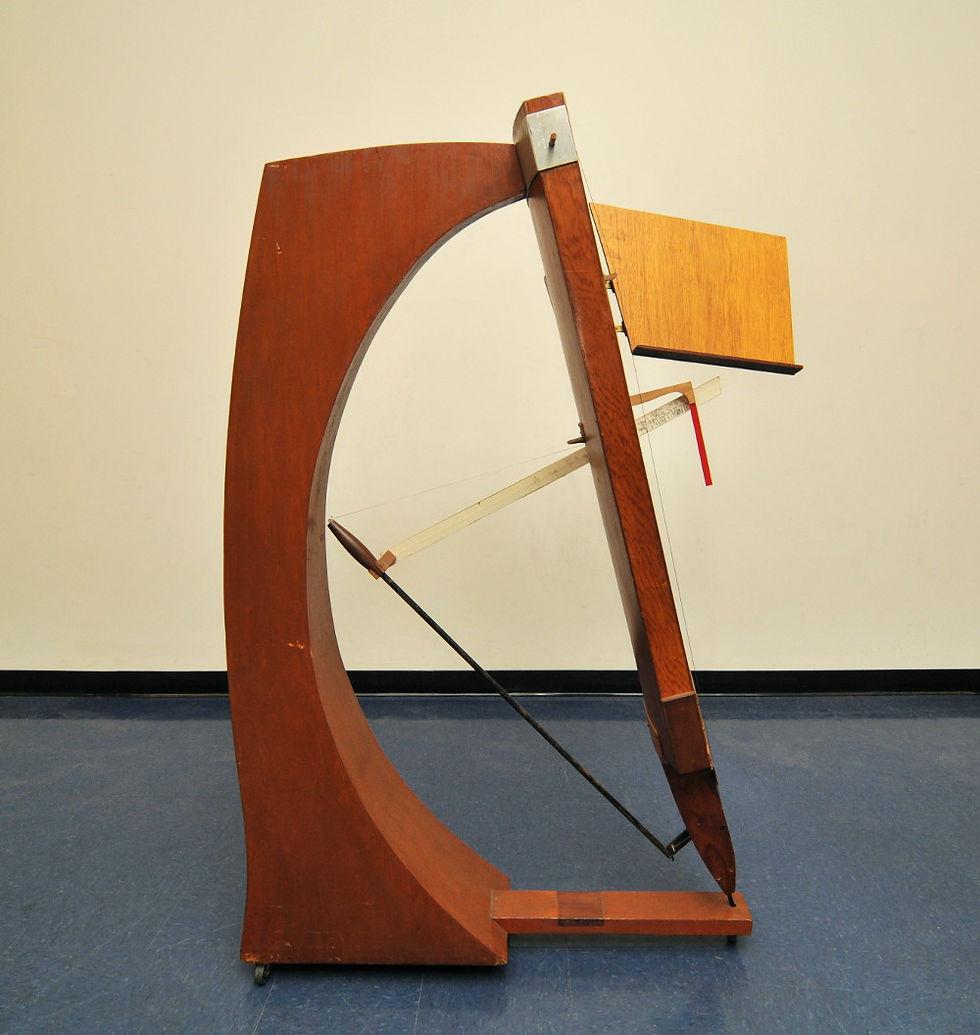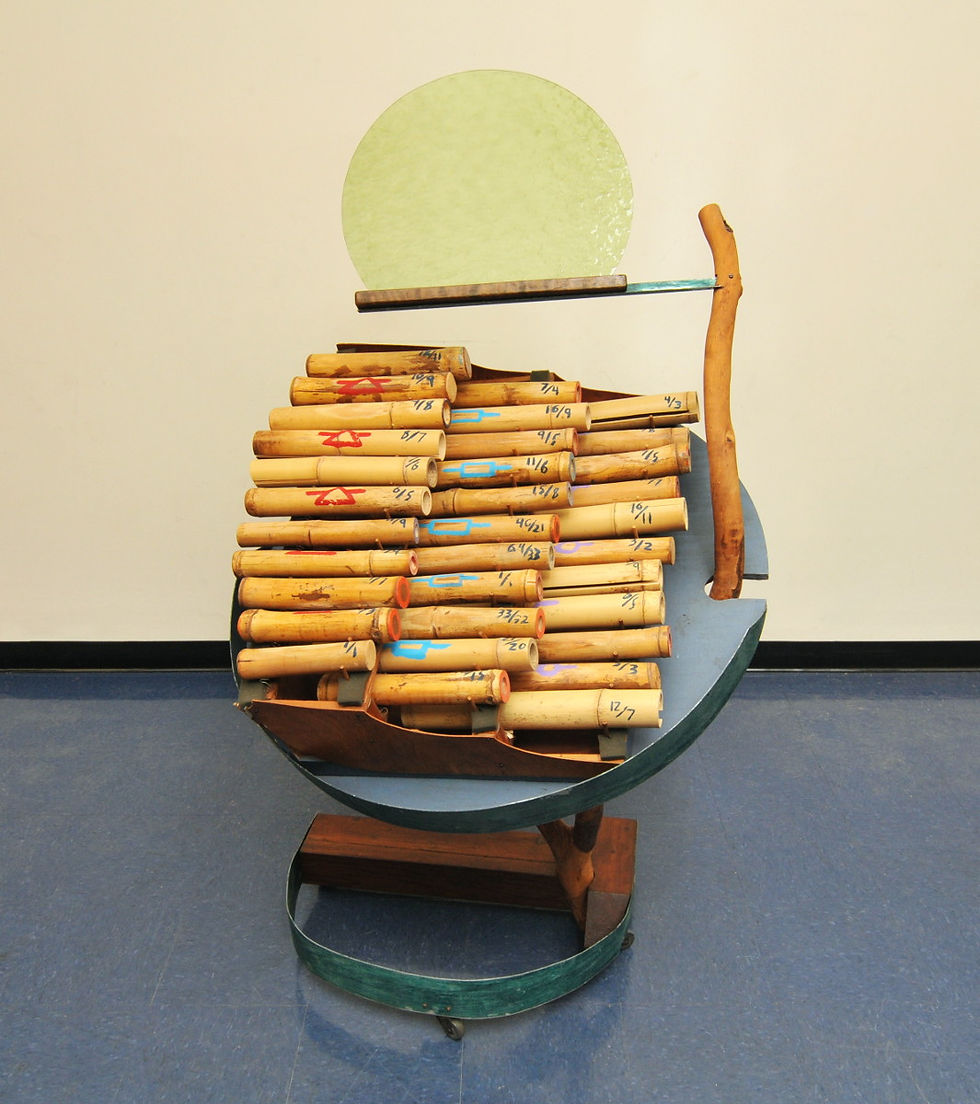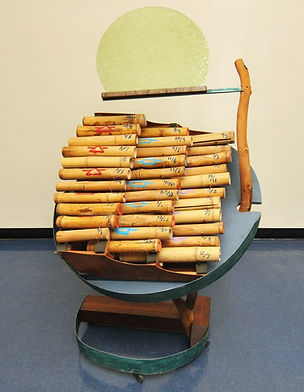


Chromelodeon I

Chromelodeon II

Bloboy

Adapted Viola

Adapted Guitar I

Adapted Guitar II

New Kithara I

Kithara II

Surrogate Kithara

New Harmonic Canon I

Castor & Pollux

Blue Rainbow

Koto

Crychord

Diamond Marimba

Quadrangularis Reversum

Bass Marimba

Marimba Eroica

Boo I

Boo II

Cloud-Chamber Bowls

Spoils of War

Mazda Marimba

Zymo-Xyl

Gourd Tree & Cone Gongs

Eucal Blossom
Chromelodeon I

Chromelodeon I is an adapted reed organ that plays a 43-tone per octave scale. In addition to a standard keyboard and a collection of stops, it includes an additional keyboard of Partch’s own creation called the sub-bass (upper left).
Chromelodeon II
Chromelodeon II is an unusual 88-key reed organ, retuned to fit Partch's system. The various stops on Chromelodeon II make it possible for full triads to sound with just one key depressed.

Bloboy

A powerful bellows is the main body of the Bloboy, forcing air through an antique auto horn and three organ pipes. Partch himself refers to the Bloboy as a contraption, but one that gives a realistic impression of a passing freight train.
Adapted Viola

The Adapted Viola is a standard viola body with an extended fingerboard. Numerous brass brads are placed in the fingerboard alongside each string to assist the player in finding the pitches in Harry's just-intoned scales.
Adapted Guitar II

Partch's Adapted Guitar II is a Hawaiian-type guitar, consisting of ten strings which are typically tuned to Harry's 16/9 Otonality or 4/3 Utonality. The headstock has a mechanism that allows the player to change the tuning in just a few seconds. Like Adapted Guitar I, this guitar is placed upon the lap and played like a slide guitar.
Adapted Guitar I

While Partch built several instruments called Adapted Guitar I, this is the one he ultimately settled upon. It is placed upon the lap and played like a slide guitar. All six strings are tuned to Harry's 1/1, though not necessarily in the same octave.
Kithara II

At nearly seven feet tall, Kithara II requires players to stand on a riser. On one side (visible in this photograph), the riser is movable, and can be taken away with no effect. On the other, the body of the Kithara opens into the riser, using it as a resonator. Kithara II has twelve sets of six strings which correspond to Partch's primary tonalities; four of these employ Pyrex rods as movable bridges.
New Kithara I

A redesign of Harry's original Kithara I, New Kithara I has 72 strings arranged into twelve six-string hexachords corresponding to Partch's twelve primary tonalities, four of which employ Pyrex rods as movable bridges.
New Harmonic Canon I

New Harmonic Canon I is a near-identical copy of Harmonic Canon I, with very similar measurements and a slightly different appearance. It was built primarily to accommodate a second tuning so that constant restringing would not be required.
Surrogate Kithara

Originally invented when a Kithara II part was too difficult for one person to play, the Surrogate Kithara quickly became a valuable member of Harry's orchestra. It features two sets of eight strings, each with a Pyrex rod.
Harmonic Canon III
Blue Rainbow

Harmonic Canon III, also called Blue Rainbow, has two resonating boxes with 44 strings across the top. These rest on a frame supported by a blue arch, both giving the instrument its name and allowing the canons to bounce and sway while being played. In this photo, the bridges are set for Delusion of the Fury.
Harmonic Canon II
Castor & Pollux

Harmonic Canon II, also called Castor and Pollux, features two resonating boxes with 44 strings across the top; these boxes rest in a redwood tray. Bridges are placed beneath the strings specifically for the tuning of each composition. In this photo, the bridges are set for U.S. Highball.
Crychord

The Crychord is a monochord initially invented by a student at the University of Illinois. The rod adjusts the tension of the string to change the pitch.
Koto

Partch's Koto is an adaptation of the Japanese instrument, given to him by Lou Harrison. This Koto is not traditional, featuring an enhanced resonance and other modifications. It uses thirteen nylon strings, stretched over easily-movable bridges.
Quadrangularis Reversum

The Quadrangularis Reversum has a mirror reverse of the Diamond Marimba in the center, with an additional 21 alto bars. The sides are natural branches of eucalyptus.
Diamond Marimba

The Diamond Marimba, aside from being a prominent percussion instrument in many of Partch's works, is also a physical manifestation of one of his crucial theoretical concepts, the Tonality Diamond. The instrument contains all twelve of his primary tonalities, each laid out in a series of thirds. In total, the Diamond Marimba has 29 distinct pitches, each of which is a member of two or more tonalities.
Marimba Eroica

Each of the four bars of the Marimba Eroica is suspended over its own cave-style resonator; two bars are situated on either side of the trapezoidal riser where the player stands. The range of the Marimba Eroica extends below that of the piano.
Bass Marimba

The top of the bars of Harry's Bass Marimba are five feet above the floor, and the player must stand on a riser which is six feet wide and just over two feet tall, making competent footwork just as important as skilled hands for any Bass Marimbist. Each bar is situated over an organ pipe which serves as a resonator.
Bamboo Marimba II
Boo II

Bamboo Marimba II, or Boo II, uses the same tuning as Boo I, but is made entirely from mottled Japanese bamboo, and each segment is open on both ends.
Bamboo Marimba I
Boo I

Bamboo Marimba I, commonly called Boo I, consists of 64 segments of bamboo. Each piece is closed on one end with a tuned tongue cut in the open end. Boo I uses bamboo from Japan, the Philippines, and California.
Spoils of War

The Spoils of War takes its name from the seven artillery casings that hang from the top of the instrument. The main body of the Spoils of War also serves as a resonator for the pernambuco bar on top. The instrument also has four Cloud-Chamber Bowls, two pieces of tongued bamboo, one woodblock, three steel Whang Guns, and a guiro.
Cloud-Chamber Bowls

Among the most iconic of Partch’s instruments, the Cloud-Chamber Bowls are large Pyrex gongs with a beautiful and complex sound. Partch initially discovered the Cloud-Chamber Bowls at the University of California, Berkeley, where portions of Pyrex carboys were discarded by the Radiation Laboratory. Over the years, he would cut countless new Cloud-Chamber Bowls to expand his set or replace those which had broken.
Zymo-Xyl

Three distinct types of sounds are possible on the Zymo-Xyl. The front resonator supports bars of white oak, the back resonator holds glass liquor and wine bottles, and on the side are two Ford hubcaps and one kettle top.
Mazda Marimba

The Mazda Marimba uses 24 light globes with the internal components removed. When struck with a rubber mallet, the globes create a sound similar to a quiet coffee percolator.
Eucal Blossom

The Eucal Blossom has 33 sections of tuned thick-walled bamboo and produces crisp, bright tones. The instrument rests on a large circular disc which is supported by a branch of eucalyptus.
Gourd Tree & Cone Gongs

Although the Gourd Tree and the Cone Gongs are entirely separate instruments, they are often handled by the same player. The Gourd Tree has twelve temple bells attached to gourd resonators, each of which hangs suspended from a eucalyptus branch. The cone gongs are sections of two nose cones from airplane fuel tanks, mounted on a small redwood base in a way that suggests a strange variety of mushroom.